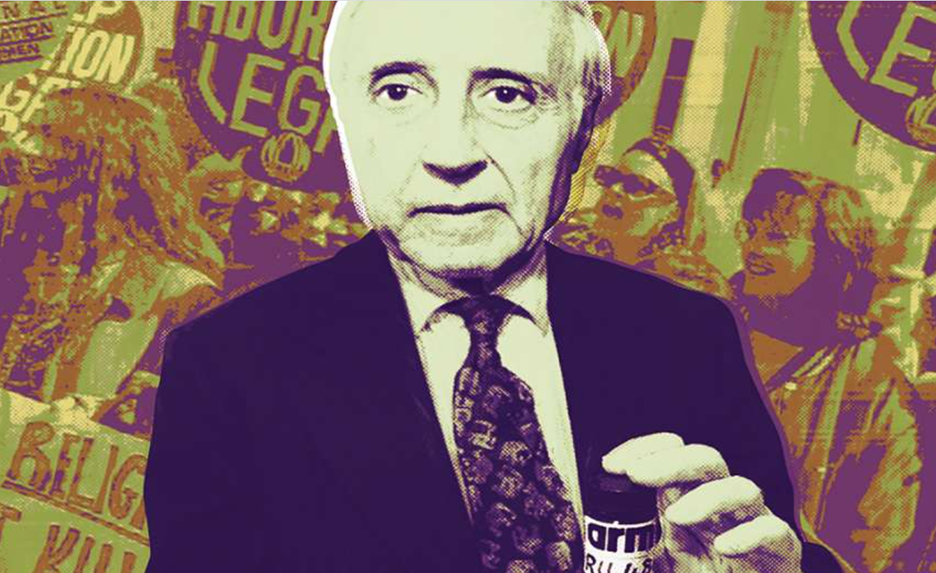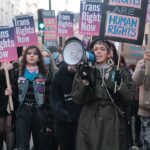Blog Post
How one man sold the feminist movement on abortion
By Jonathon Van Maren
For decades, the feminist movement has been synonymous with abortion advocacy. When I reported on the Women’s March in 2017, abortion was pushed by nearly every speaker as fundamental to feminism, and icon Gloria Steinem, then 82-years-old, sat smiling serenely on the dais. Many believe that the sexual revolution and the women’s movement have always been one and the same—that feminists championed feticide to secure their freedoms. In fact, this was not always the case. The early suffragettes and feminists were, almost without exception, anti-abortion, from Victoria Woodhull to Susan B. Anthony.
And according to Sue Ellen Browder in Subverted: How I Helped the Sexual Revolution Hijack the Women’s Movement, there was a single moment when everything changed.
I’ve read many histories of the sexual revolution, but Browder’s memoir unique. Her reinterpretation of history points to a crossroads where the women’s movement could have been something radically different than a bought-and-paid for PR arm of the abortion industry—but made the wrong choice. History is messy and specific events rarely explain complex social movements, but sometimes history really does hinge on moments. Browder makes the case that there was such a moment, when the sexual revolution and the women’s movement merged, that changed everything. Her historical counterfactual makes one wonder what could have been, if this moment had not happened—or if it had gone differently.
Browder had a front row seat to the sexual revolution working for Helen Gurley Brown, the founder of Cosmopolitan and author of Sex and the Single Girl. Brown was the female Hugh Hefner, pushing promiscuity, adultery, and a lifestyle of sex and materialism. She herself, incidentally, remained faithful to a man she remained married to for over half a century. Browder writes that it was standard practice for Cosmopolitan writers to make up evidence they couldn’t produce—anecdotes were invented, too. Lies in the service of the sexual revolution were expected. Moral compromise rarely limits itself to specific sins. Browder wrote what she calls propaganda for the magazine for two decades.
“Cosmo Girls” were Big Business’s dream come true. “She worked hard, bought lavishly from the pharmaceutical, medical, beauty, fashion, and travel industries, and (the triple perk) she didn’t push for all those pricey, bothersome extras like family tax breaks, maternity leave, shorter work weeks, and more flexible work arrangements,” Browder observed.
The sexual revolution was also good for the markets, bringing sales of “the Pill and other contraceptives, lacy underwear, makeup, singles-only cruises, pornography, sexy red convertibles, STD treatments, abortions, marital counseling, divorces, and even in-vitro fertilization treatments when young women chemically neutered themselves for so long they passed their prime childbearing years and could not longer conceive naturally without help from a doctor.”
Initially, the women’s movement and the sexual revolution were running on different (although frequently parallel) tracks. Abortion was controversial within the ranks, and Betty Friedan, the de facto leader and author of the 1963 runaway bestseller The Feminine Mystique, hadn’t even mentioned feticide in her book. She was focused on enabling women to do “creative work” that was fulfilling, not creating sex-drive consumers. Frieden called Cosmopolitan “quite obscene and quite horrible”—her vision for women included motherhood, while Helen Gurley Brown believed that motherhood, more than a lack of educational or economic opportunities, held women back. In Brown’s view, the female super-power—the “built-in mechanism in their bodies that allows them to have babies”—was a barrier to female liberation because it didn’t allow them to live like men.
Browder lays the responsibility for the legalization of abortion in the United States primarily at the feet of a single man: Larry Lader. Lader was Margaret Sanger’s biographer, a magazine writer, and the co-founder of NARAL who passionately believed in both sexual liberation and population control. Abortion, Lader believed, was a powerful weapon against religion that, if legalized, could strike “at the whole system of sexual morality to which the middle class gave lip service…to tamper with [abortion] meant that the whole system of [sexual morality] could come tumbling down.”
Lader was a master propagandist, and he made it his mission to persuade Friedan to make abortion a central plank of the women’s movement while she still exercised an outsize influence. If Lader could get Friedan on board and she could manhandle her cohorts into the service of the abortion industry, Lader could couple the sexual revolution with the women’s movement. In fact, he was frustrated that Friedan—along with African American women and other factions of the movement—seemed so reticent.
To that end, Lader published a 212-page book in 1966 titled simply Abortion. Lader claimed that the abortion movement was the moral successor of the civil rights movement; that pregnancy was equivalent to slavery; that abortion laws should be abolished; even that it was unlikely the baby had a soul before the mother could feel her kicking. He invented history, too—much of the abortion history in his book was conjured by Cyril Chestnut Means Jr., a New York Law School professor who later became a NARAL attorney. (The revisionist history in Lader’s book was later extensively debunked in a 1,283-page volume Dispelling the Myths of Abortion History by Joseph Dellapenna.) It was an incredibly influential and deadly book, giving intellectual fodder to activists everywhere. Friedan wrote a glowing review of it.
In June of 1966, Friedan had famously scribbled the goals for the National Organization for Women (NOW) on a napkin in the Washington Hilton Hotel. Her vision then was simply to bring women into the American mainstream—full equality. Abortion (and birth control, for that matter) were not mentioned. But at the second national NOW conference on November 18, 1967, at the historic Mayflower Hotel in Washington, D.C., she changed her tune. There were 89 people registered and 105 in attendance. The goal of the two-day conference, closed to the press, was to hammer out the agenda of the women’s movement. Unbeknownst to many, Friedan had been persuaded by Lader to champion abortion, and it was her goal to nail down an abortion plank in the centre of the feminist platform.
One of the leaders present that day was 72-year-old Marguerite Rawalt, a friend of both Eleanor Roosevelt and the pro-life suffragette Alice Paul. With Friedan, Rawalt was leading the meeting. The two had very different backgrounds, and very different views on women’s liberation. Friedan’s marriage, rife with affairs and occasional violence, would eventually implode; Rawalt remained married for 26 years. Rawalt was a life-long Presbyterian; Friedan signed the Humanist Manifesto II. Could common ground be found at a meeting of American women of all backgrounds?
At first, it looked likely. The meeting proceeded smoothly on Saturday morning, with all agreeing on equal pay for equal work and a greater focus on political engagement.
The afternoon meeting began at 2 PM. Pauli Murray, a civil rights and labor activist who had been on the original committee which laid the groundwork for NOW and had been arrested for violating Virginia segregation laws fifteen years before Rosa Parks, became furious as Friedan hijacked the session over the issue of the Equal Rights Amendment. Opponents of the ERA were shut down, while proponents were given ample time to speak. Despite the fact that Murray had written much of NOW’s five-page “Statement of Purpose,” she stormed out of the meeting and sent a telegram withdrawing her nomination to NOW’s national board. The following Tuesday, she sent a seven-page letter stating that the conference had been “not broadly representative of women in the same sense” that the 1966 conference had been. There were no Catholics, few ethnic minorities, few mothers, and nobody representing the poor.
But it would get worse.
Friedan saved the secret abortion resolution for last, stunning many delegates—including Marguerite Rawalt—and calling for a full repeal of abortion laws. Even those who favored a less restrictive regime were generally unwilling to go that far, and the meeting spiraled out of control, with student activists and radicals present in force to vote for the abortion plank. As Browder noted, most of them had bought Larry Lader’s line that without abortion, there could be no freedom. Many attendees realized that the issue would split the women’s movement and advocated putting abortion off for a year, until it could be considered further. Rawalt was livid—she hadn’t been told abortion was going to be on the table. The meeting was acrimoniously adjourned for an abortion statement to be written—but when they reconvened, members voted for a repeal of all abortion laws.
The final vote was 57 to 14—71 out of the 105 attendees. Despite extensive research and eye-witness interviews, Browder could not uncover what had happened to the rest of them.
It was that resolution, passed two hours before midnight on November 18, 1967, that redefined the women’s movement forever. A majority of American women did not support abortion, but “the Mere Fifty-Seven,” as Browder called them, pulled off a stunning coup. “On that tragic night, in the paltriness of an earthly moment, the women’s movement was sharply scissored into two irreconcilable factions,” Browder wrote. “Women for legal abortion on demand, and women who opposed it.” The following Monday, a press release and a news conference were held. The hot debate surrounding abortion was ignored, and the breaking story was a dream come true for Larry Lader: The women’s movement wanted abortion.
Betty Friedan was speaking for 57 activist women but claimed to be speaking for 28 million working women. The Washington Post and other papers headlined it, and other organizations followed NOW’s lead in rapid succession: the ACLU, Planned Parenthood, and others. Friedan would later boast that abortion only became a big issue when her movement decided to champion it, and she was right. “By inserting demands for abortion, contraception, and sex education into NOW’s ‘Bill of Rights,’ she had inadvertently bound the women’s movement and the sexual revolution so tightly together in many people’s eyes that the two movements would forever be seen as one and the same,” Browder wrote.
Lader had chosen his champion, and the media chose theirs. With Friedan’s movement committed to feticide, many women struck out to create their own organizations—but their work was almost totally ignored by the media. Elizabeth Boyer resigned from NOW to create the Women’s Equity Action League, successfully fighting for many pro-woman policies without ever advocating abortion. Feminists for Life was founded by two former NOW members—Pat Goltz and Catherine Callaghan—in Columbus, Ohio on April 9, 1973. They did so, Cindy Osborne wrote, because they “were deeply disturbed because the women’s movement was caving to the demands of the patriarchy by allowing itself to be used by rich industrialists, the population control movement, and the playboy movement.”
Pat had gotten kicked out of her local NOW chapter for criticizing abortion, and she and Callaghan believed that the feminist movement had totally failed to provide alternatives for women. Abortion and contraception were tickets into a man’s world where men got sex and women got abortions—but still couldn’t get maternity leave or other meaningful social policies. The women’s movement became the driving force behind the ideology of the sexual revolution that stated that women could do everything men could do—they’d simply have to sacrifice their children. Meaningful, structural change that permitted women to have children and not, for example, be fired for getting pregnant (as both Friedan and Browder were) took a back seat.
Women also poured into the pro-life movement. At a Planned Parenthood of America event at Rockefeller University on September 15, 1979 to honor Margaret Sanger, writer Michael Harrington told the crowd that his travels across America had convinced him that the pro-life movement was “one of the few genuine social movements of the 1970s” despite being an “anti-women’s women’s movement.” The New York Times noted with concern that abortion groups “are worried that their movement lacks that kind of vitality,” and NYT columnist Gail Collins noted that: “By the end of the 1970s, the National Right to Life Committee claimed more than eleven million members.” By contrasts, NOW had a mere 100,000.
The pro-life movement is still larger than the feminist movement, although you won’t hear anyone in the media saying so. Pro-life women in politics are despised by feminist leaders because their presence emphasizes the fact that the feminist movement does not, in fact, speak for the majority of women. In fact, Democratic pollster Celinda Lake noted several years ago that “women are much less likely to be pro-choice’” than men, which is an inconvenient fact for a movement that claims to represent the rights of women. Might everything have been different if Betty Friedan hadn’t sold out to Larry Lader? Or if she’d lost the vote that night in the Chinese Room of the Mayflower Hotel? Or if the women’s movement had dedicated itself not to abortion, but to empowering mothers? Sadly, of course, we’ll never know.
Perhaps that moment was a hinge upon which history swung; perhaps leaders like Gloria Steinem would have accomplished the hijacking later. Either way, November 18, 1967, marked the death of a united women’s movement—and heralded the destruction of millions of lives by abortion. Generations of women were promised freedom and got feticide. Friedan’s legacy, ultimately, is one of tragedy, death, and grief—and that makes the very thought of that other, long-forgotten path a profoundly painful one.








